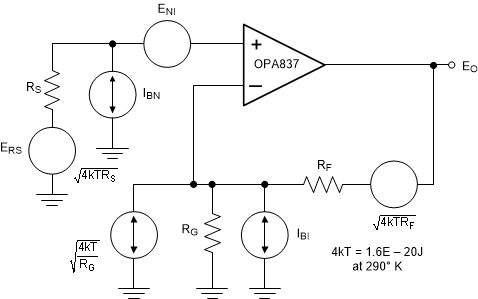SBOS673D September 2017 – December 2018 OPA2837 , OPA837
PRODUCTION DATA.
- 1 Features
- 2 Applications
- 3 Description
- 4 Revision History
- 5 Pin Configuration and Functions
-
6 Specifications
- 6.1 Absolute Maximum Ratings
- 6.2 ESD Ratings
- 6.3 Recommended Operating Conditions
- 6.4 Thermal Information: OPA837
- 6.5 Thermal Information: OPA2837
- 6.6 Electrical Characteristics: VS = 5 V
- 6.7 Electrical Characteristics: VS = 3 V
- 6.8 Typical Characteristics: VS = 5.0 V
- 6.9 Typical Characteristics: VS = 3.0 V
- 6.10 Typical Characteristics: ±2.5-V to ±1.5-V Split Supply
- 7 Detailed Description
-
8 Application and Implementation
- 8.1
Application Information
- 8.1.1 Noninverting Amplifier
- 8.1.2 Inverting Amplifier
- 8.1.3 Output DC Error Calculations
- 8.1.4 Output Noise Calculations
- 8.1.5 Instrumentation Amplifier
- 8.1.6 Attenuators
- 8.1.7 Differential to Single-Ended Amplifier
- 8.1.8 Differential-to-Differential Amplifier
- 8.1.9 Pulse Application With Single-Supply Circuit
- 8.1.10 ADC Driver Performance
- 8.2 Typical Applications
- 8.1
Application Information
- 9 Power Supply Recommendations
- 10Layout
- 11Device and Documentation Support
- 12Mechanical, Packaging, and Orderable Information
Package Options
Mechanical Data (Package|Pins)
Thermal pad, mechanical data (Package|Pins)
- RUN|10
Orderable Information
8.1.4 Output Noise Calculations
The unity-gain stable, voltage-feedback OPAx837 op amp offers among the lowest input voltage and current noise terms for any device with a supply current less than 0.7 mA. Figure 76 shows the op amp noise analysis model that includes all noise terms. In this model, all noise terms are shown as noise voltage or current density terms in nV/√Hz or pA/√Hz.
 Figure 76. Op Amp Noise Analysis Model
Figure 76. Op Amp Noise Analysis Model The total output spot noise voltage is computed as the square root of the squared contributing terms to the output noise voltage. This computation is adding all the contributing noise powers at the output by superposition, then taking the square root to return to a spot noise voltage. The last term includes the noise for both the RG and RF resistors. Equation 5 shows the general form for this output noise voltage using the terms presented in Figure 76.

Dividing this expression by the noise gain (NG = 1 + RF / RG), as shown in Equation 6, gives the equivalent input referred spot noise voltage at the noninverting input.

Using the resistor values listed in Table 2 with RS = 0 Ω results in a constant input-referred voltage noise of < 7 nV/√Hz. Reducing the resistor values can reduce this noise value towards the 4.7 nV/√Hz intrinsic to the OPA837. As shown in Equation 5, adding the RS for bias current cancellation in noninverting mode adds the noise from the RS to the total output noise. In inverting mode, bypass the RS bias current cancellation resistor with a capacitor for the best noise performance. For more details on op amp noise analysis, see the Noise Analysis for High-Speed Op Amps application report.